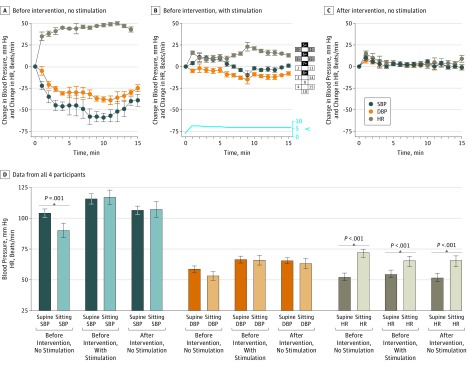Figure. Cardiovascular Response to Orthostatic Stress With Stimulation and After Cardiovascular Stimulation Intervention.
A, Exemplary data from participant A41 before the intervention without stimulation demonstrates a significant decrease (P < .001) in mean systolic blood pressure (SBP) and diastolic blood pressure (DBP) and increase (P < .001) in heart rate (HR) during a sit-up test. B, Before the intervention with stimulation, there was no significant decrease (P = .72) in mean SBP and DBP, while HR increased significantly (P < .001) during a sit-up test. Amplitude of stimulation is represented in volts; configuration of the numbered electrode array is illustrated at right: black is anode, gray is cathode, and white is inactive. C, After the intervention without stimulation, there was no significant decrease (P = .42) in SBP and DBP, while HR increased significantly (P = .002) during the sit-up test. D, Data from all 4 participants are averaged for these conditions; stimulation is depicted by diagonal bars. In all participants, before intervention without stimulation, mean SBP decreased significantly from supine to a sitting position (P = .001). The decrease in mean DBP from supine to a sitting position was not significant (P = .64). Mean HR increased significantly (P < .001) from supine to a sitting position. Before intervention with stimulation, there was no significant difference in SBP and DBP from supine to a sitting position (SBP, P = .15; DBP, P = .16); HR increased significantly (P < .001). After intervention without stimulation, SBP and DBP was not significantly different from supine to a sitting position (SBP, P = .36; DBP, P = .87); HR while sitting increased significantly from supine to a sitting position (P < .001). Error bars indicate SD.

